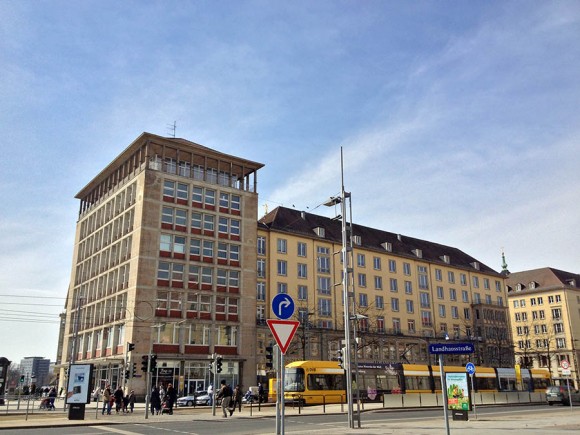I just got back from a short trip to Dresden. My parents treated us to the hotel, so we had to go with their choice of location in the fringes of the renovated old town. It proved to be a decent place and took us past the very interesting Pirnaischer Platz each day. Here, two buildings stood out, necessitating some further research.
The first one, pictured above, fed into my growing affection for tower blocks (check out my friend East-Berliner’s collection of shots). It’s known as “Hochhaus Pirnaischer Platz” or “P 27”. Built between 1964 and 1966, it’s one of the few international style manifestations in the former GDR (another one, arguably, to be found in Berlin’s magnificent Haus des Lehrers).
It’s 50 meters tall with 14 stories and was apparently designed to house mainly young people: Of its 180 units, 60 are studios and 120 one bed-room flats. A large restaurant in the building seated more than 400 people.
Most striking was the large inscription at the building’s top: “der Sozialismus siegt” (socialism triumphs), installed in 1968 and quietly removed two years before the end of the GDR in 1987. You can still see traces of the text if you look carefully:
For me, this building represents an important part of German history and the GDR’s architectural heritage. Perhaps I’m especially intrigued given my enthusiasm for buildings of the same vintage in Tokyo. Yet reading about the building has also taught me more about Dresdeners’ very ambivalent relationship with history and architecture.
Dresden was almost completely destroyed during WWII. Despite its frequent instinct to tear down historical buildings damaged during the war (e.g. Berlin’s city palace), the GDR government left most of Dresden’s ruins stand to be reconstructed later (including the Semperoper).
This accurate rebuilding of the city found its pinnacle in the Frauenkirche and the adjacent Neumarkt, opened to much fanfare in the 2000s. Currently, the Residenzschloss is in the last phases of its reconstruction, marking an end to the “rising from the ashes” of the city’s historic centre.
Obviously this is a huge and complex debate, but I sympathise with observers who have called Dresden the “Las Vegas at the Elbe” – referring to a strange obsession with history that does not exist in most of our living memories, referring to identity as an often arbitrary place in the past.
Going back to the Pirnaischer Platz, the tower block was sold to an Israeli investor a few years ago but modernisation has since stalled, leaving most flats uninhabited. Meanwhile, living conditions deteriorate, and many of the flats are rat and roach infested.
Many Dresdeners do not like the ensemble of the square and single out P 27 as one of the reasons. In their minds, it needs to go – it’s an ugly tower block akin to the many hundreds dotting the outskirts of East German cities. Showing a perhaps similar instinct, many Dresdeners also have their problems with the Kulturpalast on Neumarkt and its current upgrade.
Another interesting building on the Pirnaischer Platz is the adjacent office building Wilsdruffer Str. 3, built – just a few years before the tower block – between 1959 and 1960. Described as an example of New Objectivity (Neue Sachlichkeit), it signifies a change of direction in East German architecture, away from emotional worker-centric architecture to calmer and cooler expressions mirroring some pre-war Bauhaus elements.






We’ll never just thoughtlessly pass Pirnaischer Platz again. Danke für die schönen Tage!